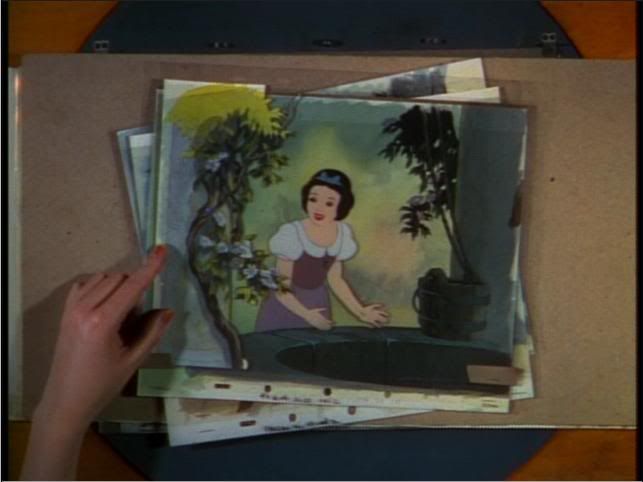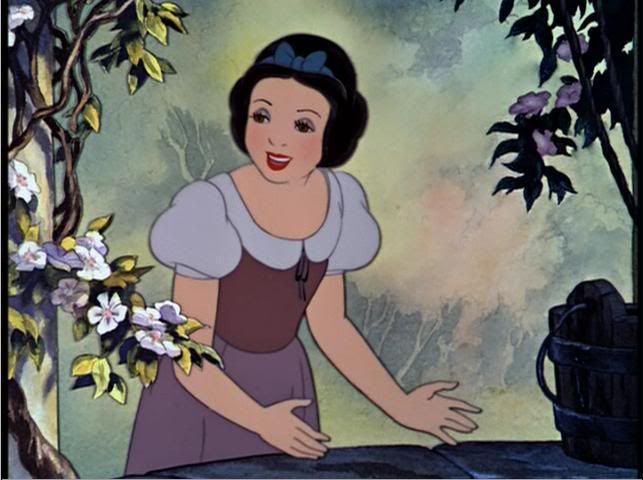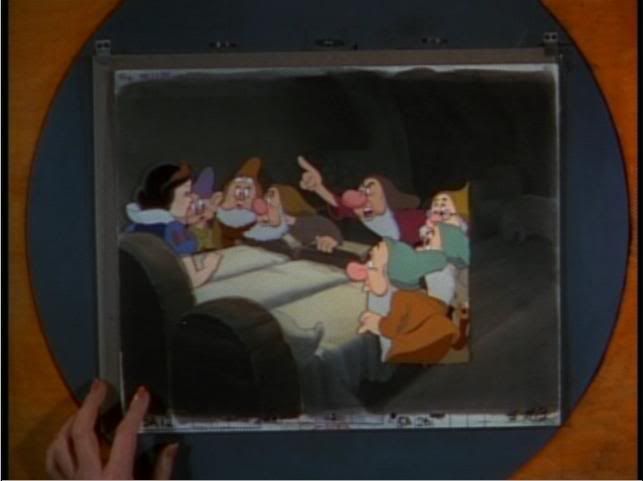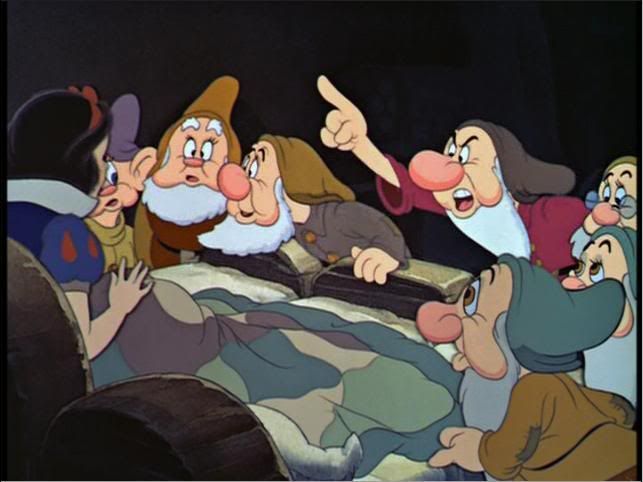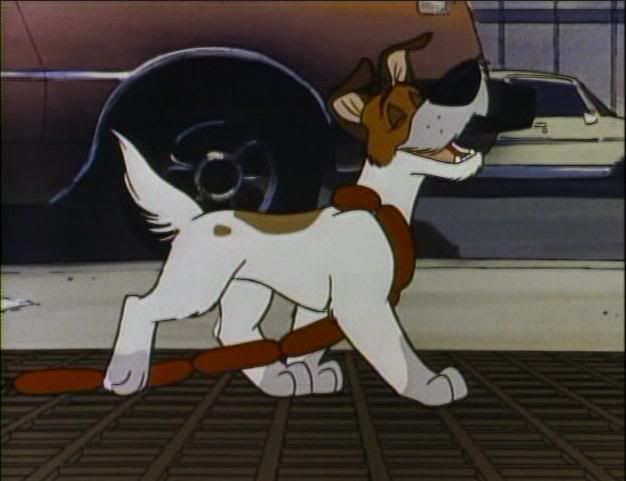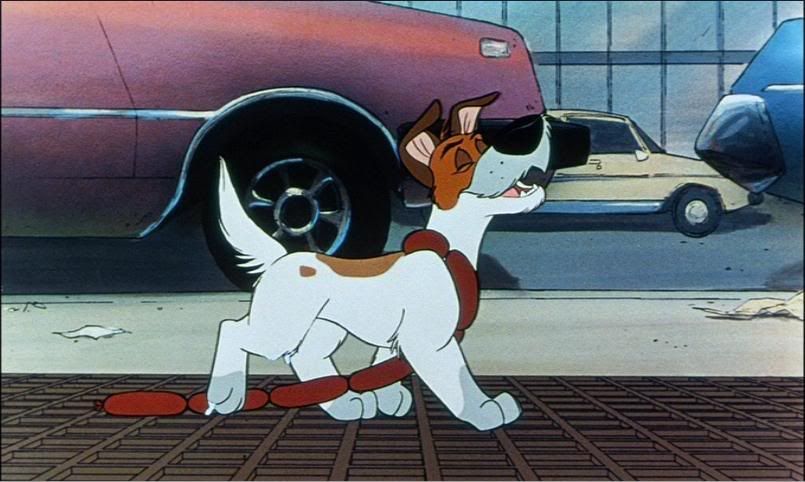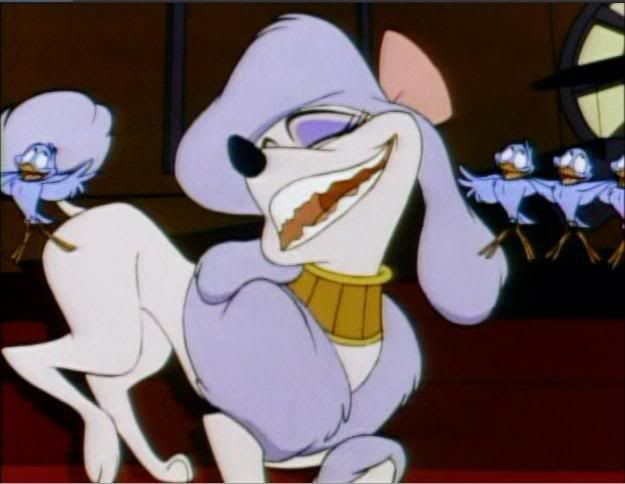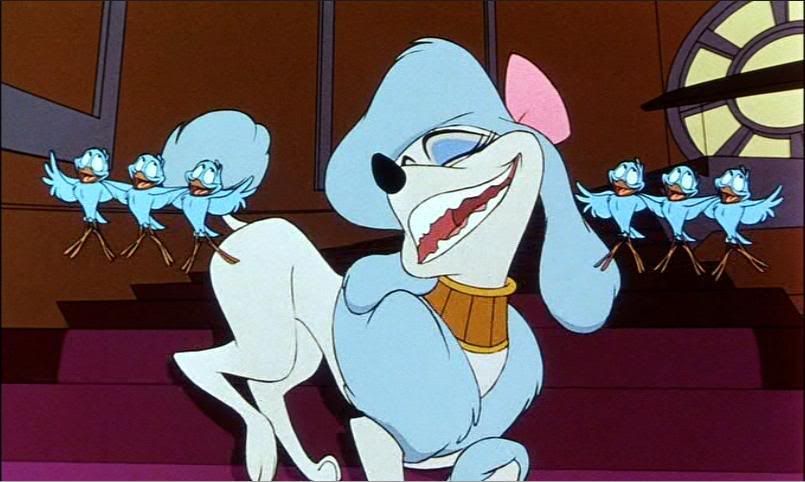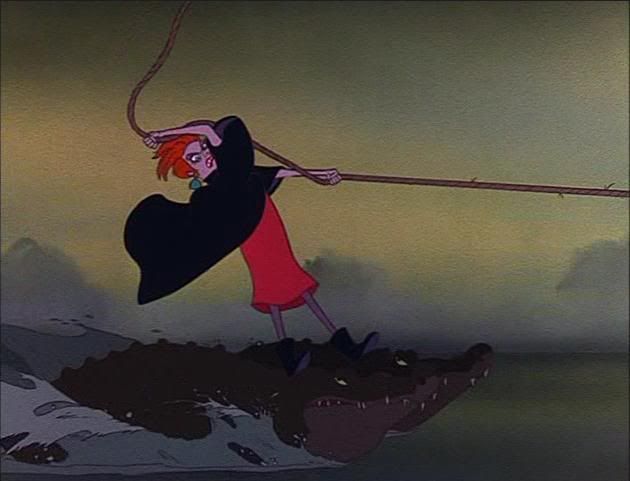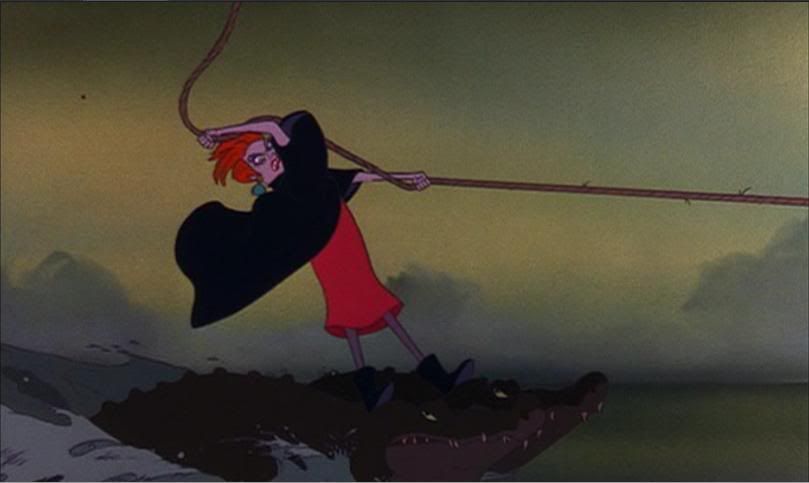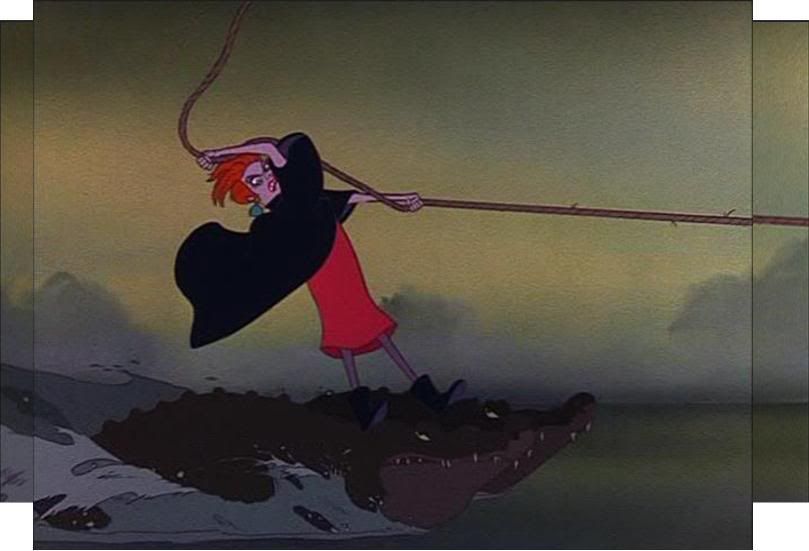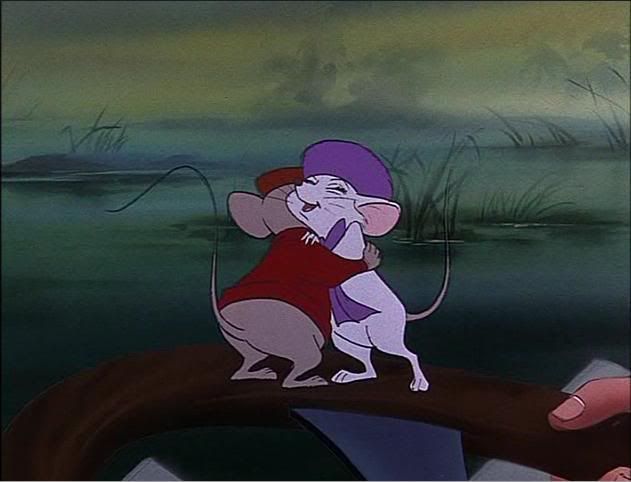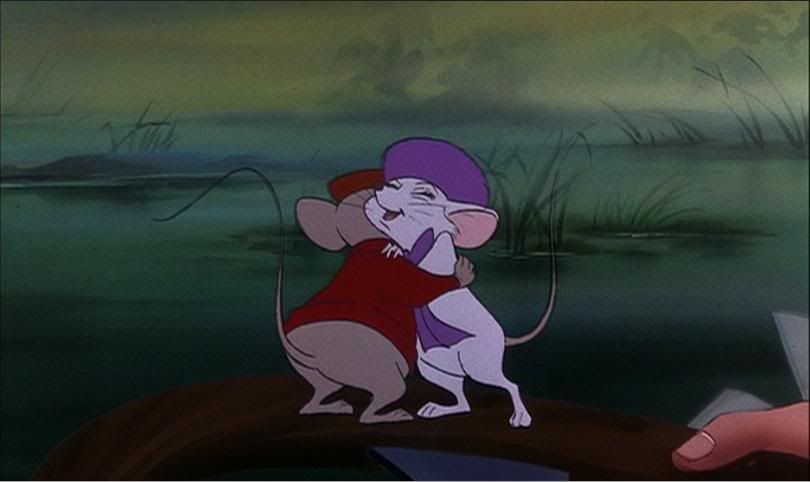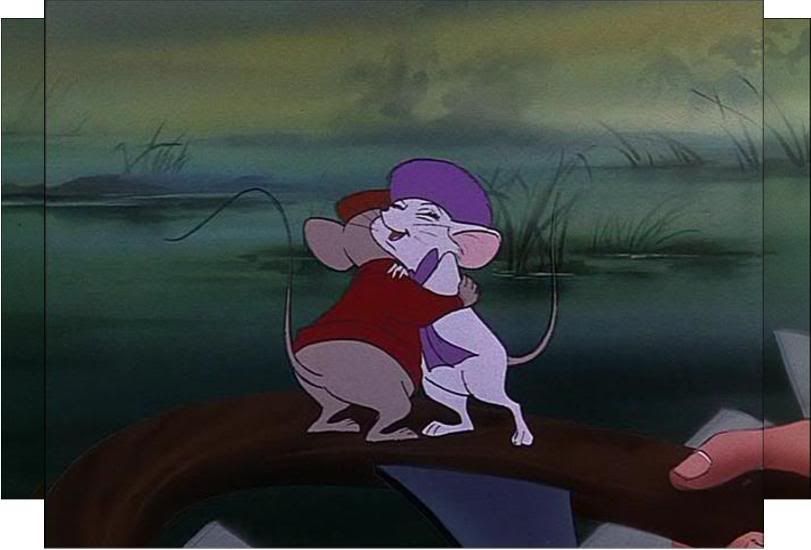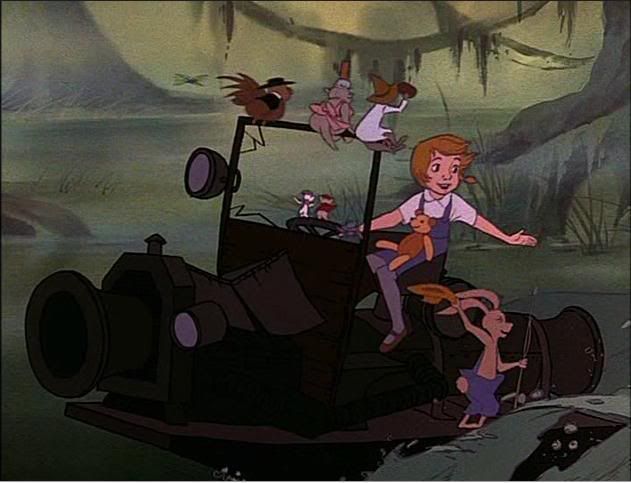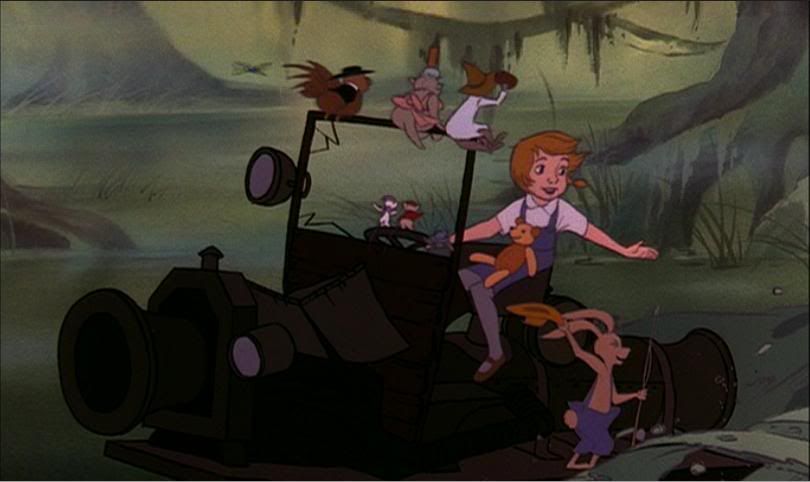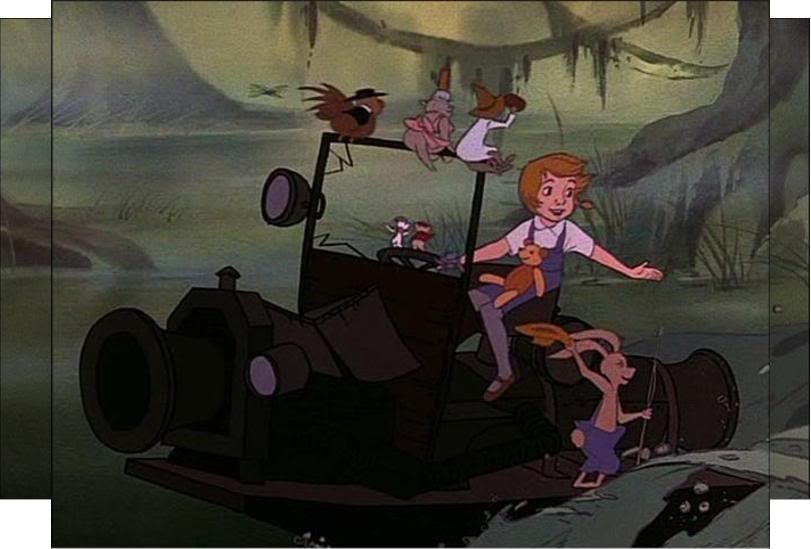Page 2 of 4
Posted: Sat Dec 27, 2008 2:32 pm
by Escapay
Posted: Sat Dec 27, 2008 3:51 pm
by Escapay
Posted: Sat Dec 27, 2008 7:19 pm
by Neal
I don't understand your point, Escapay...?
I don't really think zooming in is necessary ... that is all they did there. It's better than when they chop off the tops and bottoms of films to create a wide screen look... but still ... why change anything at all?
Posted: Sat Dec 27, 2008 7:20 pm
by Flanger-Hanger
OK I guess OaC isn't Scaps.
Oy vey, more importantly The Rescuers could use a good scrubbing.
Well I'm glad some folks here like Disneyfella and AlwaysOAR like the matting cause like it or not that's what Disney will most likely be giving us in the future if all screens are going to be wider.
Posted: Sat Dec 27, 2008 8:10 pm
by Escapay
Neal wrote:I don't understand your point, Escapay...?
My point was that you said that whatever the ratio was that they drew in is the only correct aspect ratio, regardless of what was presented in (and assuming, filmed for) theatres. And obviously from the caps, they chose to only film a certain portion of what was drawn. Heck, even the cap that shows Snow and the Dwarfs shows that they stopped drawing a certain portion of the dwarfs, but what was actually put to film cut off even more! Thus, a silly jab of "SW isn't in the right aspect ratio after all!"

Wire Hanger wrote:Oy vey, more importantly The Rescuers could use a good scrubbing.
True dat.
albert
Posted: Sat Dec 27, 2008 8:19 pm
by Neal
Yes, in the bedroom scene the dwarves only go so far, so the zooming appears necessary...but in the well scene they cut off a huge portion of the well which was not necessary.
More times than not, the cuts are NOT necessary.
Posted: Sat Dec 27, 2008 8:26 pm
by Escapay
Neal wrote:.but in the well scene they cut off a huge portion of the well which was not necessary.
Is the film any better or worse if we see a whole bucket as opposed to half a bucket? Heck, if Disney hadn't shot footage like that (I forget where it came from, either a promotional piece from 1937 or a "Disneyland" episode), a lot of people would be in ignorant bliss and not be aware there's a whole other half of a bucket there.

It's been filmed and projected that way for the past 70+ years, and likely every other animated movie since has been drawn with more image than what was photographed onto the original camera negatives. Should anyone really cry "foul!" if they're only discovering now that there's more than meets the eye when it came to the original cels and backgrounds?
albert
Posted: Sat Dec 27, 2008 8:31 pm
by Neal
I'm not one of those crazy elitists who's now going to boycott the film, start advocating against the October 2009 DVD on forums, and write Disney angry letters - but I can still scratch my head and wonder why they couldn't just show us the whole thing.
Posted: Sat Dec 27, 2008 8:47 pm
by Escapay
Neal wrote:I'm not one of those crazy elitists who's now going to boycott the film, start advocating against the October 2009 DVD on forums, and write Disney angry letters
I hope I didn't come across in my last post that I thought you'd become that, if I did, I'm sorry.
Neal wrote:but I can still scratch my head and wonder why they couldn't just show us the whole thing.
Well, that's where the whole issue of framing and composing for certain shots comes in.
Should the filmmakers zoom out and have shot everything that was available, simply because it was there? Or did they choose to zoom in for a reason, because the shot works better with only a certain amount of detail visible.
For example, look at the unzoomed and zoomed version of the Dwarfs sniffing for the soup. There's a more emotional dynamic of seeing their reactions in a zoomed in version as opposed to unzoomed where the Dwarfs are still the centre of the action, but get diminished by extraneous background on all sides.
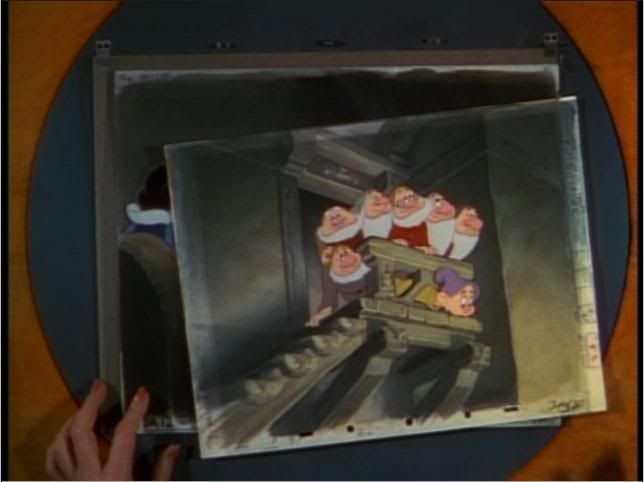
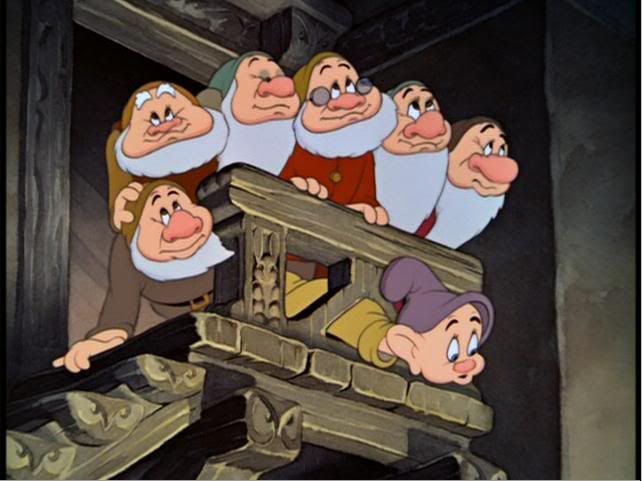
This is why I often have a problem with advocates of "Give us open-matte, we want all the picture possible!" and I'm not singling you or anyone out. Open matte doesn't even give all the picture possible (as
The Rescuers and pretty much any live-action or animated film that's matted can show), and if anything, it compromises and ruins the shots as they were originally designed for.
The Disney filmmakers knew what they were doing when they shot the films, be it zooming in and cutting off stuff that was drawn, or masking in theatres. So when I come to Disney boards and read all these crackpot "Give me the whole image, I want every little blade of grass an animator drew with his blood, sweat, and tears!" I can't help but roll my eyes and think, "Dear lord...". Because even the animators were likely aware that not everything they drew would end up on the screen. If anything, the extraneous image is a safeguard to give the cameras a little leeway when they film the cels. And by the 60s/70s, widescreen was the norm, it was no longer the exception and certainly not a novelty. Professionals would know how to draw and frame for widescreen, why should an audience second guess it simply because they're aware that there's more to a picture?
But enough about zooming in or out of The Shrill's film. I'm more interested in peoples' reactions to the new conundrum of
The Rescuers.

albert
Posted: Sat Dec 27, 2008 9:36 pm
by Neal
Well, I spoke too emphatically. There's exceptions to every rule. Sometimes it makes more sense to zoom in, I'll give you that. It's just hard to trust Disney nowadays. So many times they first pan and scan, then give us partial wide screen, then a wider wide sceen. I've lost my trust that Disney cares about what it's doing with the animation. You're way would be idyllic and acceptable - that Disney always carefully decides where to cut. If it was truly only cutting some blades of grass or trees for the sake of zooming in and fully utilizing the facial expressions or actions...then more power to them. But sometimes, with the way heads or full bodies are just cut out of scenes, I find it pretty hard to believe Disney generally gives a flying french fry where they cut the animation at.
Posted: Sun Dec 28, 2008 12:13 am
by David S.
Escapay wrote:
So when I come to Disney boards and read all these crackpot "Give me the whole image, I want every little blade of grass an animator drew with his blood, sweat, and tears!" I can't help but roll my eyes and think, "Dear lord...".
Well, there is a
HUGE difference between wanting all of the stuff that was drawn for a film on the drawing tables to appear in the film, versus simply wanting everything that is
ACTUALLY SHOT ON THE FILM PRINT to appear in the film. (especially in the case of JB, Aristocats, and RH, where the "open matte" film negative was available on home video for years and
only now that widescreen tvs are becomming the "standard", they suddenly want to take 33 % of picture
we are used to seeing in those films away)
I don't recall anyone here being upset that the directors of DACs zoomed in on certain scenes. That missing material was
NEVER part of the films in the first place.
However, IMO, once something is
FILMED and commited to the film print itself... it
IS the film, and that's why
I PASSIONATELY HATE MATTING.
And that doesn't make me, or anyone else who feels the same way, a "crackpot"!
But let's not get into a big argument about this again, especially during the holidays. We all know how each other feels about this by now, and no one is going to change anyone's minds!
I only posted in this thread to let BlackCauldron85 know that those older editions can be found at FYEs from time to time, and then to answer Neal's question about "open matte". I honestly was not looking for another arguement about this again.
(And in any case, I do not have the time to get into one, because I'll be returning to FL to finish my seasonal stay in Orlando on Monday - Magic Kingdom, New Years Eve, here I come!)



Posted: Sun Dec 28, 2008 9:57 am
by drfsupercenter
I've had good luck finding OOP DACs; unfortunately the early wave OOP Treasures sets are another story, even without the tins.
eBay and Amazon Marketplace are also very helpful. But I'm content with not *owning* them... The local library system in my area is amazing and I can get just about every Disney movie ever released on DVD for free. As long as they don't get too damaged, I'm fine just requesting them if I need them for anything.
(Plus, having a DVD burner works out well for me

)
Well, there is a HUGE difference between wanting all of the stuff that was drawn for a film on the drawing tables to appear in the film, versus simply wanting everything that is ACTUALLY SHOT ON THE FILM PRINT to appear in the film. (especially in the case of JB, Aristocats, and RH, where the "open matte" film negative was available on home video for years and only now that widescreen tvs are becomming the "standard", they suddenly want to take 33 % of picture we are used to seeing in those films away)
I agree with that. With movies like Snow White, they may have drawn it zoomed out and then realized later on it worked better a different way... and that's fine. But why would they film the 70s and 80s films in Academy ratio if they had no intent to actually show them that way?
And another point is that they actually DID release it in open matte. If they didn't intend for that open matte to be seen, why would they have released it in open matte? I mean, I know it's not "cheap" to pan-and-scan something, but Disney didn't used to be cheap, either. I know they put a lot of effort into their laserdisc releases, and most of those are open matte as well.
And, for example, the first Harry Potter movie. I have read that it was shot in open matte because they were on a low budget... and then matted to 2.35:1 for theaters.
However, look at the widescreen vs. fullscreen home video releases. The fullscreen version is actually pan-and-scanned from the widescreen. Meaning they truly intended it to be in 2.35:1 and didn't want anyone to ever see the top and bottom of the frame.
Now I need to find that recording I made of the most recent Great Mouse Detective VHS and do some frame comparisons to the DVD... I might need to look into the laserdisc release now if the DVD is indeed tilt-and-scanned.
(Oh, and that probably explains why the only two laserdisc releases are both 4:3... since most of those were open matte, not pan-and-scan)
Posted: Sun Dec 28, 2008 2:00 pm
by Flanger-Hanger
drfsupercenter wrote:I agree with that. With movies like Snow White, they may have drawn it zoomed out and then realized later on it worked better a different way... and that's fine. But why would they film the 70s and 80s films in Academy ratio if they had no intent to actually show them that way?
And another point is that they actually DID release it in open matte. If they didn't intend for that open matte to be seen, why would they have released it in open matte? I mean, I know it's not "cheap" to pan-and-scan something, but Disney didn't used to be cheap, either. I know they put a lot of effort into their laserdisc releases, and most of those are open matte as well.
And, for example, the first Harry Potter movie. I have read that it was shot in open matte because they were on a low budget... and then matted to 2.35:1 for theaters.
However, look at the widescreen vs. fullscreen home video releases. The fullscreen version is actually pan-and-scanned from the widescreen. Meaning they truly intended it to be in 2.35:1 and didn't want anyone to ever see the top and bottom of the frame.
Now I need to find that recording I made of the most recent Great Mouse Detective VHS and do some frame comparisons to the DVD... I might need to look into the laserdisc release now if the DVD is indeed tilt-and-scanned.
(Oh, and that probably explains why the only two laserdisc releases are both 4:3... since most of those were open matte, not pan-and-scan)
because it's a cost saving method. Like pretty much all movies not made in panavision, technirama, cinemascope etc., these films had to be shown in theatres in widescreen some how and if you want to save money you shoot in the 1.371 ratio and matte it to 1.66:1 or 1.75:1 or 1.85:1 or whatever. Animation is expensive so you save money by not drawing a bigger frame but you leave room at the top and bottom of the frame so that when matted for theaters you don't loose essential information and you get a better composition (the one intended to be seen in theaters, this is all part of the planning process when movies get made). In the case of live action some directors even put cardboard on the camera lens to simulate the theatrical experience so they can frame it better. If you don't understand the concept or importance of matting you probably have not done alot of research in the way films are made. Is it a novelty to see an unmattd image? sure, but is it not also important to consider the filmmakers view of planning and caluclating a shot?
You may also ask, why not draw a smaller frame in the intended ratio or why animate "the whole f***ing frame!!!" because the camera never stays still, it's always moving and shifting from shot to shot and characters move within it. That's why it's important to consider how the action moves within the frame and the Disney animators knew this when making their films. They didn't just lazily "chop off" the top and bottom of the picture, the composited the shots from the beginning making sure nothing important would be lost to tell the story (they are many shots in The Aristocats for example that have just background image in the upper or lower portions of the 1.37:1 frame).
Why would they release them open matte? because it's cheaper and faster then doing a pan and scan job of the matted frame, plain and simple. If you find a boom mike in the open uped portion well that doesn't matter does it?
Only some laserdiscs by Disney were open matte, since the laserdisc prints were the same as the VHS ones in the early stages (the "classics" line is a good example) they share the same ratio. The Rescuers is a good example of a pan and scan job put to laserdisc and The Great Mouse Detective was likely too.
With your harry Potter example, almost all movies made today are shot "open matte" and then cropped. tThat's nothing new or different for that one specific film, only now the camera can photograph the ratio intended to be seen on screen and when they go to make and pan and scan version they don't have that opened up frame to work with. Also wouldn't it be ridiculously silly if something with that wide a ratio was presented unmatted? considering the effort the filmmaker put into framing that 2.35:1 image would it not look rather odd to see all that superfluous info displayed in a 1.33:1 shape?
Posted: Sun Dec 28, 2008 6:01 pm
by Goliath
Flanger-Hanger wrote:As for Great Mouse Detective, I'm glad it's matted. I do think the 1992 VHS is actually pan and scan because I see more image on the DVD than I did the VHS. And if GMD is, then maybe Oliver and Company is too?
drfsupercenter wrote:Woah. Now I get it. I was thinking the bottom picture had more on the sides because it was wider... when it's really the same on the sides. I wonder how many other CAPS films were open matte? I know movies like The Little Mermaid, Beauty and the Beast, etc. were 1.66:1 as their VHS releases were pan-and-scanned from that.
disneyfella wrote:My guess is, given the recent Sleeping Beauty treatment, that we will be subjected to inferior open matte transfers on everything possible (with a cheap marketing ploy stating 'with expanded never before seen animation'), and no respect for framing or theatrical presentation will be given. These films will NOT be preserved, but rather defiled!
Well, *my* problem is I don't understand a word of what you're all writing. I'm absolutely clueless when it comes to stuff like 'ratio' and 'pan and scan' and 'matte' and what more... I don't know what things like '1.66:1' mean. So whenever a UD review mentions details about it, I'm at loss. Maybe you all think that's dumb, but I have never delved into this techincal terminology.
The only thing *I* want to know is: is it put on DVD the way it was released in theatres, or did they cut parts off (like they did with
Jungle Book)? And why do they do this?
And
disneyfella: isn't it true that the most recent DVD for
Sleeping Beauty presents the original theatrical print?
Posted: Sun Dec 28, 2008 7:37 pm
by Flanger-Hanger
Goliath wrote:The only thing *I* want to know is: is it put on DVD the way it was released in theatres, or did they cut parts off (like they did with Jungle Book)? And why do they do this?
And disneyfella: isn't it true that the most recent DVD for Sleeping Beauty presents the original theatrical print?
It sometimes is and sometimes isn't. Disney's weird like that. It's not "cutting off parts" it's how the film was shown in theaters (like it or not that's where movies are seen). That's why it's labeled "Original theatrical aspect ratio" on the back of the box.
The most recent SB release is the original animated ratio, not the theatrical one.
Posted: Sun Dec 28, 2008 7:38 pm
by drfsupercenter
Animation is expensive so you save money by not drawing a bigger frame but you leave room at the top and bottom of the frame so that when matted for theaters you don't loose essential information and you get a better composition (the one intended to be seen in theaters, this is all part of the planning process when movies get made).
Huh? They're not drawing less on the sides, they're drawing more on the top and bottom. They obviously spent the money animating it in 4:3... they could have just animated it in 16:9.
And an example of this is the anime Grappler Baki. All the DVDs are non-anamorphic, but in approximately a 1.85:1 aspect ratio. And the reason why is because they didn't draw it in high enough resolution to make it anamorphic... but they didn't finish the top and bottom area since they wanted the show in widescreen and had no intent to have it 4:3.
I have another example from the Sailor Moon movies (like the Disney classics, they were animated in 4:3 and then matted for theaters)... that presents a clear animation error because they weren't animating it for open matte releases. I don't have pictures at the moment, but I'll get some soon comparing the theatrical version to the open matte. (And for that matter - it was ONLY ever released widescreen in Japan, then the dubbed version on DVD was 4:3 but some specific scenes were letterboxed... it was only in the cheapie US VHS release where you even SEE the open matte)
And I thought most film these days is anamorphic - where the actual film negative is 1.85:1, 2.35:1 or whatever, and that's how it's made. I know Harry Potter was only shot in 4:3 because they didn't want to waste money on anamorphic cameras (or something like that)
Something like Dark City was also 2.35:1 but was released in open matte... why not pan-and-scan it like Harry Potter? And the only DVD release had both ratios (it was a flipper disc), so it's obvious they didn't mind showing people the entire frame.
Well, *my* problem is I don't understand a word of what you're all writing. I'm absolutely clueless when it comes to stuff like 'ratio' and 'pan and scan' and 'matte' and what more... I don't know what things like '1.66:1' mean. So whenever a UD review mentions details about it, I'm at loss. Maybe you all think that's dumb, but I have never delved into this techincal terminology.
That number, such as 1.66:1 is the width-to-height ratio of the movie. Traditional TVs are 4:3 (also called 1.33:1), meaning for every 4 inches across, it goes 3 inches up. (Measure a TV if you don't believe me

)
HDTVs now are in 16:9 (also called 1.78:1), and it's obvious by looking at them that they're wider than older TVs.
1.66:1 is therefore somewhere in the middle, and ratios like 2.35:1 are far wider than a typical HDTV.
As far as how it's being put on DVD - open matte is the way it was drawn, or originally filmed... the widescreen is how it was presented in theaters. Both are technically "original"... which is why there's a sorta argument among UD members as to what the "original aspect ratio" is... I consider it to be how they filmed it, whereas others say it's how it was presented in theaters. (and note the word FILMED - that's why I don't complain about Snow White, since they filmed it zoomed in)
Posted: Sun Dec 28, 2008 7:54 pm
by Flanger-Hanger
drfsupercenter wrote:Huh? They're not drawing less on the sides, they're drawing more on the top and bottom. They obviously spent the money animating it in 4:3... they could have just animated it in 16:9.
And an example of this is the anime Grappler Baki. All the DVDs are non-anamorphic, but in approximately a 1.85:1 aspect ratio. And the reason why is because they didn't draw it in high enough resolution to make it anamorphic... but they didn't finish the top and bottom area since they wanted the show in widescreen and had no intent to have it 4:3.
I have another example from the Sailor Moon movies (like the Disney classics, they were animated in 4:3 and then matted for theaters)... that presents a clear animation error because they weren't animating it for open matte releases. I don't have pictures at the moment, but I'll get some soon comparing the theatrical version to the open matte. (And for that matter - it was ONLY ever released widescreen in Japan, then the dubbed version on DVD was 4:3 but some specific scenes were letterboxed... it was only in the cheapie US VHS release where you even SEE the open matte)
And I thought most film these days is anamorphic - where the actual film negative is 1.85:1, 2.35:1 or whatever, and that's how it's made. I know Harry Potter was only shot in 4:3 because they didn't want to waste money on anamorphic cameras (or something like that)
Something like Dark City was also 2.35:1 but was released in open matte... why not pan-and-scan it like Harry Potter? And the only DVD release had both ratios (it was a flipper disc), so it's obvious they didn't mind showing people the entire frame.
Um no they couldn't have. drawing in a 16:9 ratio would require either creating a smaller frame or a bigger one, both more cumbersome for the animators and layout artists involved. Plus a camera capable of photographing more than a 4x3 shape.
Didn't mind? Or had no choice? Was it cheaper to just show it open matte than do a pan and scan job? Was it to please the minor population who want their 4x3 screen filled? Did they not "mind" because the 2.35:1 ratio was also available?
I'd like to see sources for your anime examples (quotes form individuals involved not screencaps). They didn't draw it in enough quality to make it anamorphic? Sounds sketchy to me, since anamorphic enhancement on DVDs has nothing to do with anamorphic lenses for photographing film. If anything, anamorphic enhancement on DVDs makes the image sharper and of better quality regardless of simplicity in style of drawing.
Posted: Sun Dec 28, 2008 8:01 pm
by Neal
Technically, drf, I think there could be three original aspect ratios, then:
1) The way it was originally animated
2) The way it was initially filmed
3) The way it was first presented in theaters
...it seems Disney goes with # 3 as the OAR most of the time when it comes to home releases. I'd prefer #1 because I'd say generally it's synonymous give or take a blade or grass or leaf with #s 2 and 3, so why not just show us all the work the animators did? But I admit, in some cases such as Snow White it doesn't work out right, thus I'd see #2 as acceptable.
Generally, #3 cuts off too much for my taste.
With the size of Blu-ray Discs, it'd be wonderful if Disney released all 3 versions. That'd save UD a lot of arguments and save Disney a lot of angry fans. No fan could complain that what they define as the OAR wasn't readily available.
But I should stop being such an idealist... Disney would never, ever do that.
Posted: Sun Dec 28, 2008 8:10 pm
by drfsupercenter
Why would it be any less expensive to animate it in 4:3? It's not like standard pieces of paper come in that size... LOL...
As far as quotes, I don't know of any at the moment... For the Baki thing, I think it was animated it digitally and the resolution was something like 640x360. If they made it anamorphic, it would just be stretching it, not actually doing any good. (And I'm 99% positive it was animated digitally)
I'm not that big of a Sailor Moon fan myself... so I don't even own any of them other than a copy of the region 1 DVDs. But I'll check with a friend of mine who IS a big fan and see if there's any extras that mention the aspect ratio. But I think the screenshots will speak for themselves.
Didn't mind? Or had no choice? Was it cheaper to just show it open matte than do a pan and scan job? Was it to please the minor population who want their 4x3 screen filled? Did they not "mind" because the 2.35:1 ratio was also available?
Why would they release it as a flipper at all? That costs more than just releasing a widescreen version... (Hey, two-sided media is really expensive, more so than dual layer if I'm not mistaken)
Technically, drf, I think there could be three original aspect ratios
Me too.
That's why you won't have anyone argue against you if you say the original negative aspect ratio of Beauty and the Beast is 1.66:1, and the original theatrical aspect ratio is 1.85:1.
But if I say "the original aspect ratio is 1.66:1", THAT will get some controversy.
And Disney isn't even always accurate when they say the stuff on the back of the box... One BIG example is Aladdin 3: the King of Thieves movie. It says "4:3 (Fullscreen)" on the back of the box, and it's actually 1.78:1 anamorphic widescreen. That's one BIG typo, if you ask me. (And it's direct-to-video, why the frick would they make it widescreen? There's no theatrical ratio... it was originally made in the VHS era in 4:3, so no doubt 4:3 is the one and only OAR)
With the size of Blu-ray Discs, it'd be wonderful if Disney released all 3 versions. That'd save UD a lot of arguments and save Disney a lot of angry fans. No fan could complain that what they define as the OAR wasn't readily available.
And I agree with you there. I wish companies would stop being so cheap with their releases.
Beauty and the Beast and THe Lion King Platinum Editions are just despicable... they have the "Special edition" and "original theatrical version"... but that OTV isn't even the OTV! It's just the IMAX "Special Edition" without the added scenes. Do a Google search for it, you'll be surprised. Not to mention with Beauty and the Beast, they crammed 3 "versions" on a single disc... so all 3 took a huge quality hit... (and that workprint is actually cropped from the 1.66:1 ratio it was shown in... so it's not "exactly how it was shown at the 1991 New York Film Festival" as Don Hahn so clearly said in the introduction...)
Posted: Sun Dec 28, 2008 8:37 pm
by Neal
I don't know why Hahn continually lied that The Lion King's DVD release was going to be the absolute original version. Did they not expect us to figure out that it wasn't?
Sure, people say we're just whiners that we aren't happy the crocodiles became larger and greener or the waterfall more textured... the film is largely the same so a few tiny changes shouldn't matter. It just irks me because the original animation is what made it famous. Clearly it had no problem then, why the need to improve it? That to me is like going back and changing the Mona Lisa's eye color - sure, that quixotic smile is still there which is the most important part - it's just two little dots of color that were changed, right? No biggy!?
Wrong. You don't !@#$%*& mess with the original!
